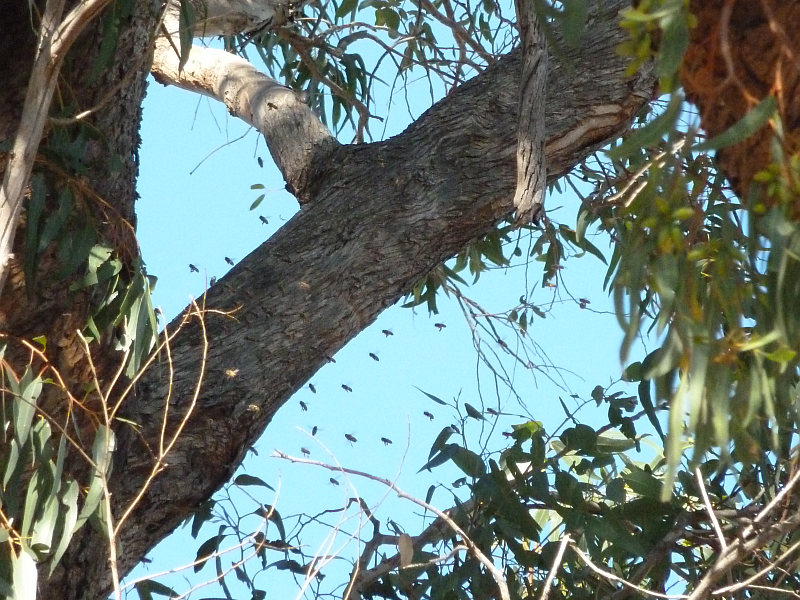The Varroa Mite ‘cloud’ with a possible ‘silver lining’: Thinking about the wicked problem of biosecurity trade-offs on our island home
Let’s go way back to the start…
I often think about the biological dilemmas we face on this island continent we call home. So much of what we consider to be unique about Australia – in terms of its biodiversity – is a by-product of its isolation over such a long period of geological time. Since Gondwana broke apart and Australia eventually separated from Antarctica 85 million years ago, this continent has been slowly drifting along alone, quietly minding its own business in the vast Southern Ocean.
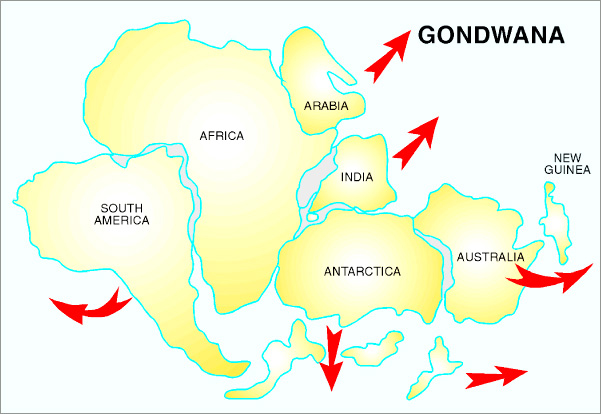
Our long-isolated evolutionary laboratory
For most of that time, Australia was essentially an isolated island laboratory, where nature was able to take its own interesting path without the possibility of species migrating in from lands far away. Of course there are early exceptions, like those species that could eventually fly in (birds and bats) or possibly drift in (such as plants, e.g. boab tree – depending on which theory of boab arrival ends up being agreed upon!), but more frequent incursions didn’t occur until Australia drifted far enough north to reach closer proximity to the land masses of the northern hemisphere in Asia, via chains of islands to our north.
Australia was initially characterised by very few new arrivals to our shores
It was at that time, still millions of years ago, that land-based species such as rats managed to bridge the gaps and arrived in two separate early waves. Aboriginal people then arrived approx. 60,000 years ago, and even later, as recently as several thousand years ago, people most likely brought dingoes across from Asia. Each time a new species arrived, there were consequences with cascading ecological impacts that are still observable in our fauna assemblages today – from human arrival contributing to the loss of megafauna to the dingo driving the mainland extinction of the Thylacine and Devil. In the case of the rodents, new endemic groups of species have evolved and descended from those much earlier arrivals. However, the fact that these arrivals over millions of years can be summarised in a sentence or two gives you an indication of just how effectively Australia was quarantined from the rest of the world, for an incredibly long time.
Everything changed suddenly from 1788
That all changed with the arrival and subsequent migration of new waves of humans (and everything they brought with them) from different parts of the world to Australia from the late 1700s, a trend that has intensified ever since. Some introductions were accidental, such as the mice and rats that stowed away on ships, causing our third and most recent wave of rodent migration to Australia. However many introductions were deliberate, as the human colonisers from Europe either sought to make Australia more like the land of their origin (e.g. foxes, rabbits, sparrows, salmonids, etc.), or later brought in species as poorly informed biological control agents, many of which sadly never even had the desired effect (e.g. cane toads and Gambusia) but continue to spread.
The speed and volume of travel has kept going up over time
Not only is Australia an island, but it is also a long way from most of the world’s other large land masses, and their resident human populations, so even after 1788 that vast distance initially provided natural advantages. For example, the transport process itself was once a form of forced quarantine, as the long, slow journey across oceans took months to complete.
However, changing technology has now turned all of that on its head. The boats carrying goods have got faster, bigger and are now capable of carrying huge volumes of shipping containers – in fact the largest container ship is now 400 metres long and can carry the equivalent of up to 24,000 twenty foot long shipping containers – on a single boat!
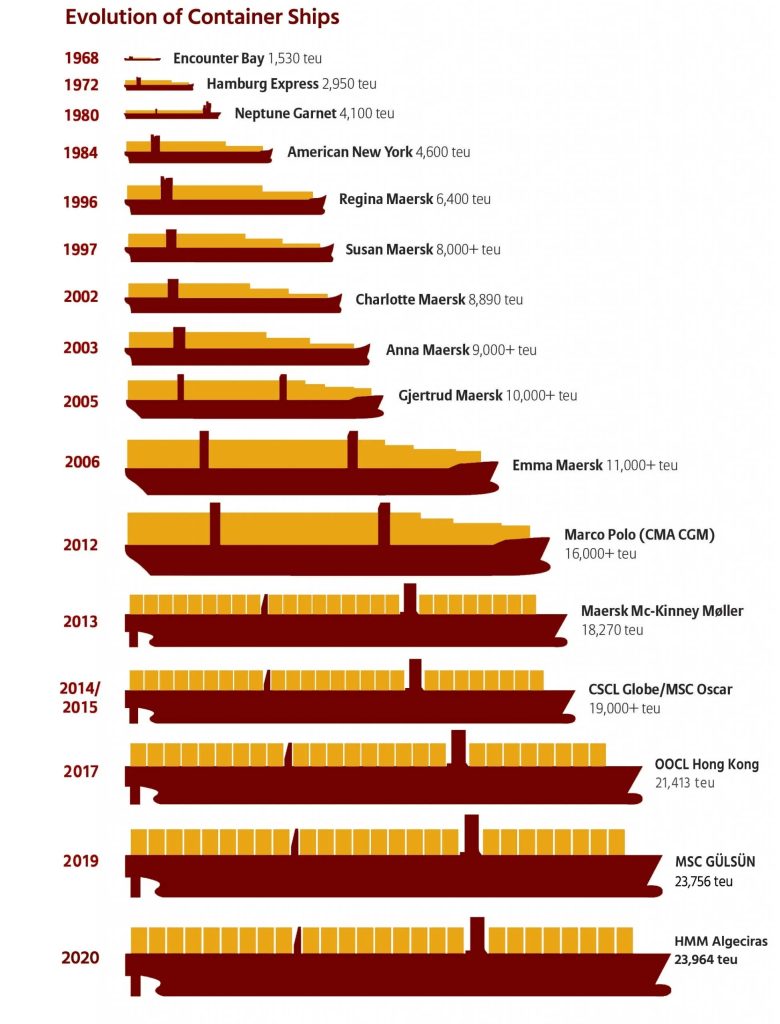
Human travel to Australia initially took months in clipper ships which relied on wind, which was unpredictable and slow. This sailing time reduced to weeks when ships with engines replaced those with sails from the mid-late 1800s, and ships continued to ferry large numbers of people right up until the 1960s and 1970s. Since that time, we have now reached the point where you can be just about anywhere in the world in a single day on a plane. The volume of human travel in and out of Australia is now measured in the millions of arrivals per month, as shown below.
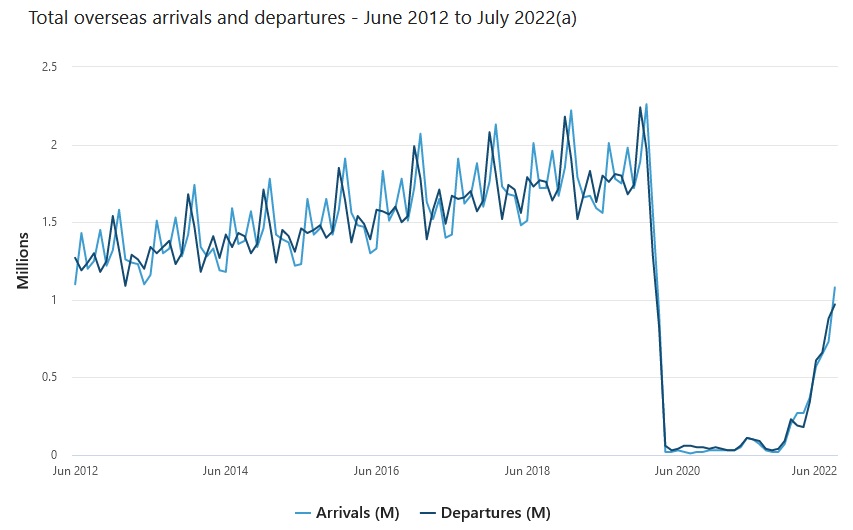
With the notable exception of the recent crash in travel over the past two years due to COVID-19, the trend of increase in human movement to and from Australia is abundantly clear.
We’ve lost the advantage of isolation, with chance now playing a bigger role in the biological future of our continent
So what does all this have to do with the Varroa Mite, or other biosecurity risks such as Foot and Mouth Disease, or other pests or pathogens?
For the mathematicians amongst you it will already be obvious, but for everyone else this is a pretty simple exercise of logic that we can readily step you through.
In short, when the sheer numbers get this big, then the chance of a really low probability, random risk actually occurring becomes increasingly likely, over time maybe inevitable. Millions of humans (and their luggage), or thousands of shipping containers, moving into and out of Australia every month increases the likelihood of these improbable biosecurity risks slipping through the cracks and finding their way onto our shores.
An example of this phenomenon linked to human movement is the case of Myrtle Rust, which arrived in Australia in 2010.
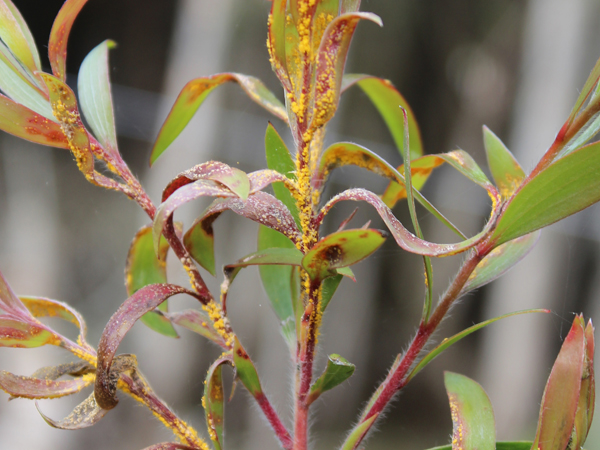
While no-one knows for sure how it arrived, it seems likely that it may have been introduced by a single traveller inadvertently carrying rust spores on their clothing, luggage or camping gear, after flying in from South America to New South Wales. Once established in the humid NSW bush, it rapidly spread all along the east coast and into northern Australia, transported by wind. In 2022, the spread continues, with a recent incursion detected in Western Australia. We still don’t fully understand the potential long-term impact of this introduced fungus on the vast Myrtaceae family of plants across the continent (think gum trees, bottle brushes and tea-trees, for a few examples), but it is likely to drive some of the most susceptible species to extinction.
Alternative examples of chance incursions of insect species that have hitchhiked their way to Australia in various ways, including freight transport or in shipping containers, are not hard to think of.
Growing up in Adelaide, I was aware that the Portuguese Millipede was a relatively recent arrival, apparently first detected in the 1950s after their accidental introduction to South Australia and spreading quickly. The species is now found in all of Australia’s southern states – ably assisted in its secondary spread by the human fascination with moving soil and pot plants from place to place. When you move house, do you take the pot plants with you?
But 15 years ago, I was given a clear reminder that this decades-long invasion process is not yet complete, when I moved to the bush near Rennick in SW Victoria, and discovered that there were no introduced millipedes. It was hard not to notice because where we’d lived previously at Mt Schank and Mt Gambier the limestone walls of buildings would be covered in thousands of them as they emerged from the soil each autumn. For most of the first 10 years, we remained millipede free, but my efforts were ultimately futile – as we could literally see the invasion ‘front’ coming down the limestone tracks through the nearby pine forests a few kilometres to the west, getting closer and closer each year. I have often wondered what changes are happening to the native insect life on the forest floor now that the Portuguese Millipede ‘wave’ has arrived. These ecosystem transformations are still quietly unfolding every day in our environment, usually unseen and unnoticed.
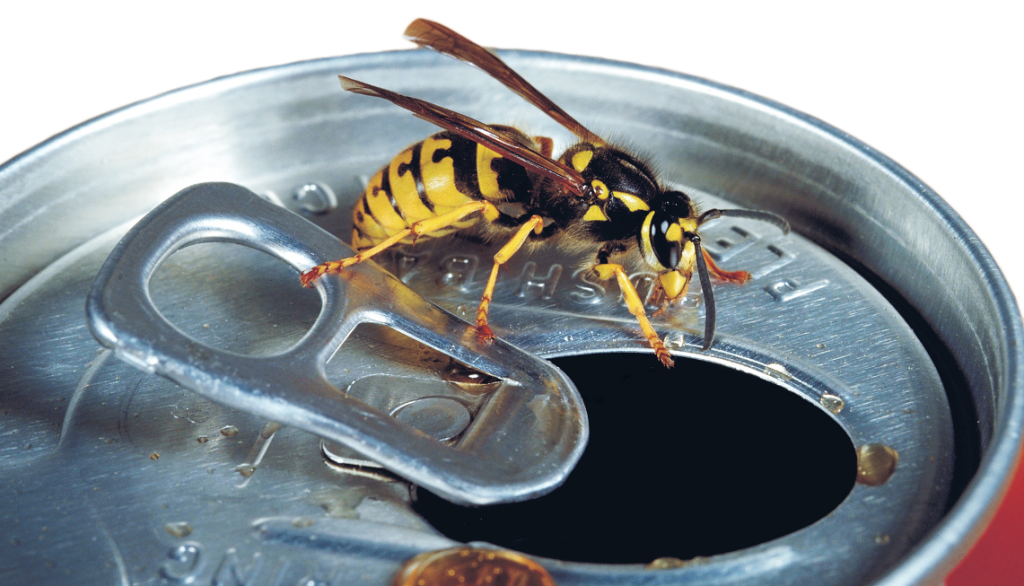
And how could we forget other hitchhikers like the European Wasp, first detected in Tasmania in 1959 but now ubiquitous in the wild across temperate southern Australia, the Fire Ants first detected in Queensland in 2001, and Yellow Crazy Ants threatening the Queensland Tropics. All of these unwanted arrivals entered via our ports.
With modern global trade and human movements trending as they are, our biosecurity system is under constant and increasing pressure to find and manage these metaphorical ‘needles’ in the vast number of ‘haystacks’ now entering Australia every year. Without making big changes to our behaviour or the economic system, ironically like those of the magnitude and breadth suddenly thrust upon us by COVID-19 (as shown on the chart above), there are no easy answers to this enormous biosecurity challenge.
The story of the European Honey Bee
One species of insect of immense economic value that was deliberately taken all over the world, where it also escaped and naturalised wherever it went, was the European Honey Bee (Apis mellifera). This species was first brought to Australia for honey production in the early 1800s, and is now also used in a coordinated way at an industrial scale to increase the pollination rate of many commercial crops and orchards.
This means that the European Honey Bee has been interacting with Australian native ecosystems for the best part of 200 years. Indeed, the species has been feral in our bushland for so long, that we don’t truly understand the full scale or magnitude of the impact it has been having in competing with native wildlife for hollows, pollen and nectar resources – including birds, mammals and other native insects.
The arrival of the Varroa Mite
The recent detection of the Varroa Mite in NSW, a parasite of the European Honey Bee whose original host was a close cousin (the Asian Honey Bee – Apis cerana), has understandably been cause for alarm among apiarists, given that Australia is the last continent to have remained free of this mite. The Varroa Mite not only directly weakens the European Honey Bee, but also carries other pathogen risks. Because it did not co-evolve with the mite, these bees are especially susceptible to this parasite, as well as the viruses carried by the mite which are capable of causing the dramatic collapse of entire bee colonies. However, given the global spread of the mite over the past century, directly facilitated by stowaway feral bee swarms on international ship freight or on other boats, its arrival on our shores has been considered inevitable for some time. Nearby New Zealand succumbed a little over 20 years ago – so it has really only been a question of when, not if, it would arrive.
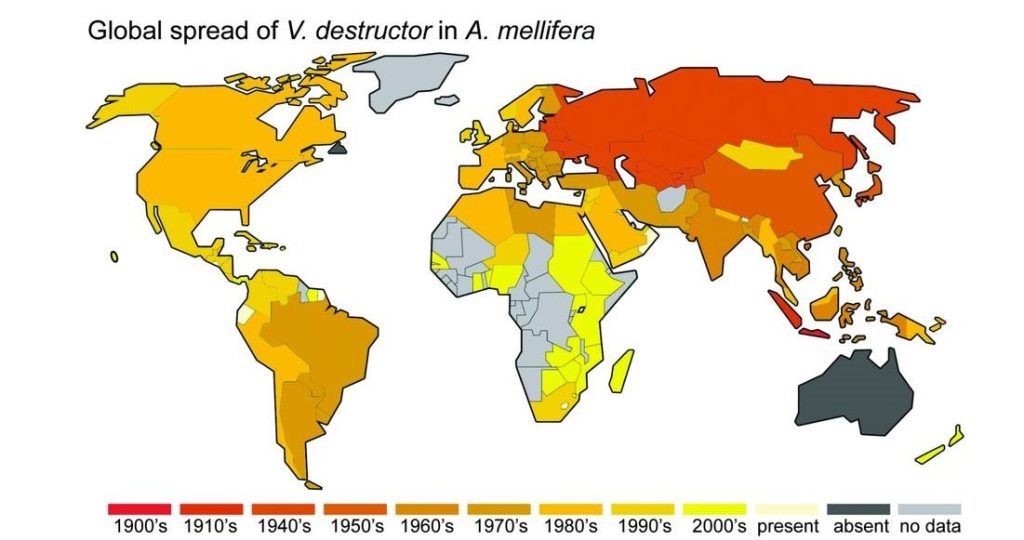
After a scare in north Queensland in recent years with another species of Varroa Mite (Varroa jacobsoni), detected (and eradicated) in a small area within a wider incursion of the Asian Honey Bee which has now naturalised in that area, the most serious Varroa Mite species of concern (Varroa destructor) was detected two months ago near Newcastle in NSW. Given the subsequent distribution that has been recorded in northern NSW, it seems that the species has been present for several months and was slowly spreading prior to its detection in sentinel hives.
A broad response is currently underway, which is aiming for eradication and having a devastating economic impact on some apiarists whose livelihoods have collapsed overnight as a result of drastic measures being implemented for the greater good. All hives within the infected areas are being progressively destroyed in an attempt to eliminate the outbreak, and movement of bee hives is being limited (both within NSW and between states) given the concern about inadvertent spread in commercial hives used for pollination services being transported over vast distances.
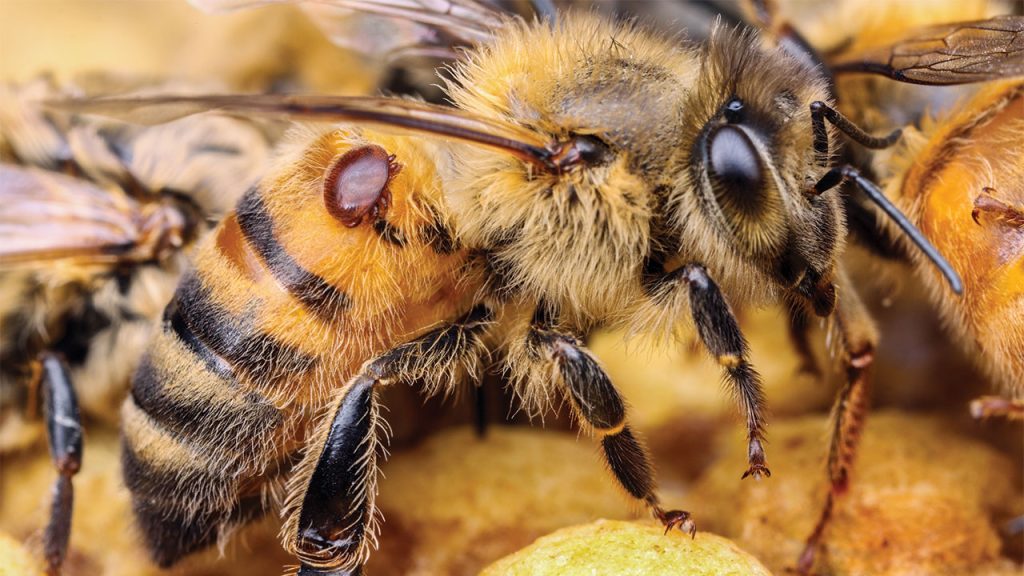
Can the Varroa Mite be eradicated?
Because the Varroa Mite has been such an effective global invader of European Honey Bees, the chances of success seem remote. We also have a potential blind spot in the response currently underway that few people are talking about – an exception (asking whether we realistically can stop the outbreak) is Professor Sasha Mikheyev from ANU. This is because, while all the hives kept by beekeepers are now being checked for the mite as part of control efforts, the big question that remains unanswered is whether the mite is now already spreading unchecked in the feral bee population. If it is, then – irrespective of what we do with managed hives – the progressive spread of the Varroa Mite across the Australian continent from the current outbreak might already be inevitable.
We are fortunate that what we choose to do next to support bee-keepers and provide pollination services can be informed by the experience of apiarists in New Zealand, who have managed to adapt their practices to co-exist with the mite. There are also those scientists who have anticipated this day coming, and thought about what we could learn from New Zealand when our time to deal with this issue arrived. Unfortunately now that it has, the days of truly ‘organic’ honey may soon be over, as hives might need to be treated with low dosages of miticide to keep the mites under control.
But what might this mean for the Australian bush?
If we put the very real social and economic impacts, and general disruption to humans aside, we’re left with a potentially fascinating silver lining… and that is because in other places where the Varroa Mite has spread around the world, it has greatly reduced or eliminated populations of the feral European Honey Bee in the wild.
In the Australian context, that could be a game changer for our native ecosystems, by unlocking vast resources (hollows, pollen and nectar) that are currently utilised by feral bees. Indeed this and other indirect impacts are a fascinating topic explored in some detail by Associate Professor Patrick O’Connor from the University of Adelaide, who started a discussion on this subject over the past couple of months. You can read his article in the Conversation here, and a follow up half-hour long chat he had with Eastside FM here.
There are lots of questions that linger, including whether the now naturalised Asian Honey Bee incursion in Queensland will gradually take its cousin’s place by spreading across the continent in the wake of a European Honey Bee collapse. One thing is for sure – nature never stands still and ongoing change is inevitable; a process that has dramatically accelerated due to our behaviour as a species at a global scale.
While this is a challenging topic, it is a necessary one for us to think through and be aware of, because modern human trade and movement does involve very real trade-offs for biosecurity and biodiversity for the Australian continent. This impacts our island home, so it impacts us all.
Yet, as this complex example shows, it is also not always necessary entirely bad news – because in the case of the Varroa Mite and the European Honey Bee, we may inadvertently end up with an effective bio-control agent which gives our native ecosystems and wildlife a much needed productivity boost. Interesting food for thought…
